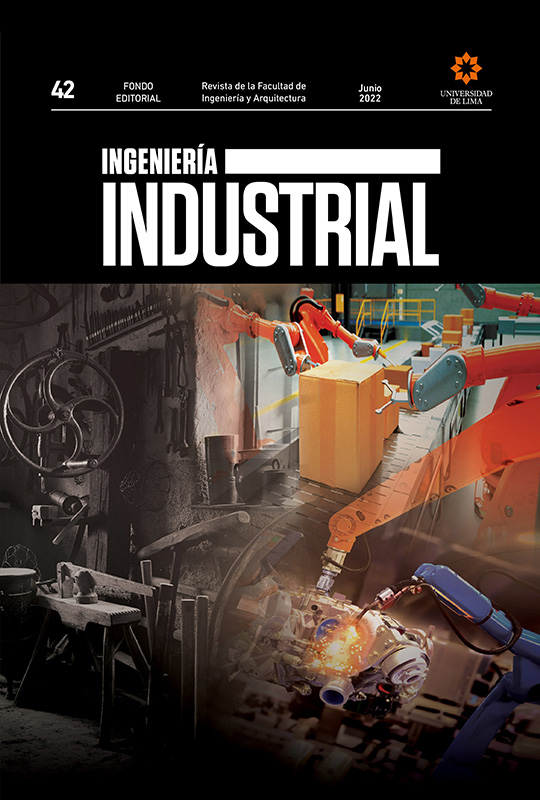Improvement of PVC compound plasticizer extraction process
DOI:
https://doi.org/10.26439/ing.ind2022.n42.5865Keywords:
extraction, continuous improvement, gases chromatography, gas chromatography coupled with mass spectroscopyAbstract
The Soxhlet method in extracting plasticizers from PVC compounds presents various areas for improvement, such as the amount of solvent used, the time required in the process, and its costs. This study proposes replacing the Soxhlet method with the ultrasound-assisted method to reduce the time, costs, and amount of solvent used in plasticizer extraction. It also proposes using solvent recovered from previous extractions to reduce costs further. The study involved experimentation with three different grades of PVC compounds (medical, cable, and profile) to compare the recovery of plasticizers by the Soxhlet and the ultrasound-assisted methods. The plasticizers obtained were analyzed using gas chromatography, gas chromatography coupled with mass spectroscopy, and Fourier-transform infrared spectroscopy to evaluate the results of each extraction method as compared to reference compounds and determine any possible interference. The proposed method yields 96 % of plasticizer extraction, a decrease from 360 to 60 minutes in the extraction process, and a decrease from 150 to 100 ml in solvent use. Complemented by the use of recovered solvent, the proposed method reduces costs from 93,000.00 to 15,000.00 Mexican pesos.
Downloads
References
Bandar, H., Hijazi, A., Rammal, H., Hachem, A., Saad, Z., & Badran, B. (2013). Techniques for the extraction of bioactive compounds from LebaneseUrtica dioica. American Journal of Phytomedicine and Clinical Therapeutics, 1(6), 507-513. https://www.imedpub.com/articles/techniques-for-the-extraction-of-bioactivecompounds-from-lebanese-urtica-dioica.pdf
Boudhrioua, M. N., M’hiri, N., Ioannou, I., Paris, C., & Ghoul, M. (2016). Comparison of the efficiency of different extraction methods on antioxidants of maltase orange peel. International Journal of Food and Nutritional Science, 3(2), 1-13. https://doi.org/10.15436/2377-0619.16.789
Briones-Labarca, V., Plaza-Morales, M., Giovagnoli-Vicuña, C., & Jamett, F. (2015). High hydrostatic pressure and ultrasound extractions of antioxidant compounds, sulforaphane and fatty acids from Chilean papaya (Vasconcellea pubescens) seeds: Effects of extraction conditions and methods. LWT– Food Science and Technology, 60(1), 525- 534. https://doi.org/10.1016/j.lwt.2014.07.057
Bromberger, M., De Marsillac, L., & Peixoto, C. (2018). Green technologies for the extraction of bioactive compounds in fruits and vegetables. CyTA - Journal of Food, 16(1), 400-412.https://doi.org/10.1080/19476337.2017.1411978
Campo Vera, Y., Gélvez Ordoñez, V., & Ayala Aponte, A. (2018). Ultrasonido en el procesamiento (homogenización, extracción y secado) de alimentos. Biotecnología en el Sector Agropecuario y Agroindustrial, 16(1), 102-113. http://www.scielo.org.co/pdf/bsaa/v16n1/1692-3561-bsaa-16-01-00102.pdf
Carciochi, R. A., D’Alessandro, L. G., Vauchel, P., Rodríguez, M. M., Nolasco, S. M., & Dimitrov, K. (2017). Valorization of agrifood by-products by extraction valuable bioactive compounds using green processes. En A. M. Grumezescu & A. M. Holban (Eds.), Ingredients extraction by physicochemical methods in food (pp. 191-228). Academic Press. https://doi.org/10.1016/B978-0-12-811521-3.00004-1
Chemat, F., Zill-e-Huma, Khan, M. K. (2011). Applications of ultrasound in food technology. Processing, preservation and extraction. Ultrasonics Sonochemistry, 18(4), 813‐835. https://doi.org/10.1016/j.ultsonch.2010.11.023
Corona, E., Martínez, N., Ruiz, H., & Carranza, J. (2016). Extracción asistida por ultrasonido de compuestos fenólicos de semillas de chia (Salvia hispanica L.) y su actividad antioxidante. Agrociencia, 50 (4), 403-412. https://agrociencia-colpos.org/index.php/agrociencia/article/view/1220
Dar, N. G., Hussain, A., Paracha, G. M.,& Akhter, S. (2015). Evaluation of different techniques for extraction of antioxidants as bioactive compounds from citrus peels (industrial by-products). American-Eurasian Journal of Agricultural and Environmental Sciences, 15(4), 676-682. https://www.idosi.org/aejaes/jaes15(4)15/28.pdf
Jakobi, R. (2002). Marketing and sales in the Chemical industry (2a ed.). Wiley-VCH.
Khan, M. K., Abert-Vian, M., Fabiano-Tixier, A.-S., Dangles, O., & Chemat, F. (2010). Ultrasound-assisted extraction of polyphenols (flavanone glycosides) from orange (Citrus sinensis L.) peel. Food Chemistry, 119(2), 851-858. https://doi.org/10.1016/j.foodchem.2009.08.046
Knorr, D., Zenker, M., Heinz, V. & Lee, D.-U. (2004). Applications and potential of ultrasonics in food processing. Trends in Food Science & Technology, 15(5), 261‐266. https://doi.org/10.1016/j.tifs.2003.12.001
Lucena, N. (2019). Extracción de productos naturales asistida por ultrasonidos. [Trabajo de fin de grado, Universidad de Jaén, Escuela Politécnica Superior de Linares, Ingeniería Química Industrial. https://hdl.handle.net/10953.1/10191
Mariano (2011, 6 de junio). PVC. Tecnología de los plásticos. https://tecnologiadelosplasticos.blogspot.com/2011/06/pvc.html
Mason, T. J., Paniwnyk, L., & Lorimer, J. P. (1996). The uses of ultrasound in food technology. Ultrasonics Sonochemistry. , 3(3), 253-260. https://doi.org/10.1016/S1350-4177(96)00034-X
Peredo, H. A., Palou, E., & López, A. (2009). Aceites esenciales: métodos de extracción. Temas Selectos de Ingeniería de Alimentos, 3(1), 24-32. https://www.udlap.mx/WP/tsia/files/No3-Vol-1/TSIA-3(1)-Peredo-Luna-et-al-2009.pdf
Shirsath, S. R., Sable, S. S., Gaikwad, S. G., Sonawane, S. H., Saini, D. R., & Gogate, P. R. (2017). Intensification of extraction of curcumin from Curcuma amada using ultrasound assisted approach: Effect of different operating parameters. Ultrasonics Sonochemistry, 38, 437-445. https://doi.org/10.1016/j.ultsonch.2017.03.040
Spinella, M. E., Fernández, M. B., Nolasco, S. M., & Figueiredo, A. K. (2015, 2-5 de agosto). Extracción de aceite asistida por ultrasonido de granos de girasol alto esteárico alto oleico. VIII Congreso Argentino de Ingeniería Química.. http://www.aaiq.org.ar/SCongresos/docs/06_029/papers/05a/05a_1816_159.pdf
Universidad Pablo de Olavide (2004). Determinación del contenido graso de leche en polvo: Extracción Soxhlet. Recuperado el 12 julio de 2021 de https://www.upo.es/depa/webdex/quimfis/docencia/TAQ/curso0405/TAQP5_0405.pdf
Ulloa, J. A., Rosas, P., Ramírez, J. C., & Ulloa, B. E. (2013). Ultrasonido: aplicaciones en el campo de los alimentos. Nueva época, (14), 1-12. https://mega.nz/file/wVR1UQrA#L3vDTxn5brRhJYRw6gZYqgeVr1R2u4IeWTU8bhFAZHM
United States Environmental Protection Agency (1996). Method 3540C: Soxhlet extraction. https://www.epa.gov/sites/default/files/2015-12/documents/3540c.pdf
United States Environmental Protection Agency (2007a). Method 3500C: organic extraction and sample preparation. https://www.epa.gov/sites/default/files/2015-12/documents/3500c.pdf
United States Environmental Protection Agency (2007b). Method 3550C: Ultrasonic extraction. https://www.epa.gov/sites/default/files/2015-12/documents/3550c.pdf
Universidad Veracruzana. (s.f.). Cromatografía de Gases / Espectrometría de Masas (GC/MS). Universidad Veracruzana. Recuperado el 30 de octubre de 2020, de https://www.uv.mx/sara/facilidades/gcms/
Wong-Paz, J. E., Muñiz, D. B., Martínez, G. C. G., Belmares, R. E., & Aguilar, C. N. (2015). Ultrasound-assisted extraction of polyphenols from native plants in the Mexican desert. Ultrasonics Sonochemistry, 22, 474-481. https://doi.org/10.1016/j.ultsonch.2014.06.001
Zhang, Z.-S., Wang, L.-J., Li, D., Jiao, S.-S., Chen, X. D., & Mao, Z.-H. (2008). Ultrasound-assisted extraction of oil from flaxseed. Separation and Purification Technology, 62, 192-198. https://doi.org/10.1016/j.seppur.2008.01.014



